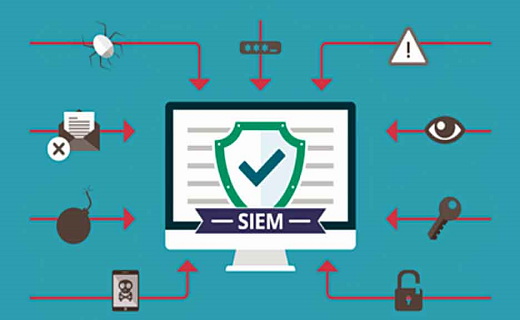Key Takeaways
- The importance and functions of Security Information and Event Management (SIEM) systems in modern cybersecurity.
- How SIEM systems enhance threat intelligence and defense mechanisms.
- Real-world examples showcasing the effectiveness of SIEM in detecting and mitigating cyber threats.
- Insights into integrating SIEM with existing IT infrastructure for optimal performance.
What is SIEM?
In the ever-evolving cybersecurity landscape, SIEM (Security Information and Event Management) systems play a pivotal role. These sophisticated systems aggregate and analyze data from various sources, from network devices and servers to applications and security appliances. By correlating this expansive array of data, SIEM solutions enable organizations to detect and respond to potential security threats more effectively and proactively, thus safeguarding sensitive information and ensuring compliance with regulatory requirements. SIEM systems act as the nerve center of an organization’s security operations, providing real-time insights into the health and security of an entire IT environment.
Importance of SIEM in Cybersecurity
SIEM systems are essential for organizations of all sizes, from small businesses to large enterprises. SIEM solutions provide a unified and comprehensive view of the organization’s security posture by consolidating logs and events from different sources across the network. This centralized approach is vital for identifying patterns and anomalies indicating a security breach or malicious activity. For instance, SIEM can detect unusual login attempts, unauthorized data access, and other suspicious behaviors that would be challenging to spot through manual analysis. Moreover, SIEM systems help organizations comply with industry regulations and standards by maintaining detailed audit logs and generating reports demonstrating adherence to security policies. Consequently, SIEM significantly enhances an organization’s overall threat detection and response capabilities while streamlining compliance efforts.
How SIEM Enhances Threat Intelligence
SIEM systems enhance threat intelligence by collecting and correlating data from many sources, including firewalls, intrusion detection systems (IDS), and other security tools. SIEM employs advanced analytics and machine learning algorithms to identify unusual activities and potential cyber threats. According to a source on TechTarget, integrating SIEM with external threat intelligence further refines the accuracy and speed of threat detection. This integration enables organizations to stay ahead of emerging threats and vulnerabilities by continuously updating their threat intelligence databases. As a result, security teams can prioritize their response efforts based on the severity and potential impact of detected threats, ensuring that critical incidents are addressed promptly and effectively.
Real-World Examples of SIEM in Action
Consider the case of a mid-sized company that experienced a targeted phishing attack. The phishing emails were designed to trick employees into divulging sensitive information. Thanks to its SIEM system, the organization could quickly identify and isolate unusual email traffic before any significant damage occurred. This swift action prevented potential data breaches and saved the company from financial and reputational harm. Another example is a financial institution that utilizes SIEM to monitor and flag unauthorized system access attempts. By continuously analyzing access patterns and correlating this data with known threat vectors, the institution ensures compliance with industry regulations and protects customer data from cybercriminals.
Integrating SIEM into IT Infrastructure
For seamless SIEM integration, it’s crucial to have a clear strategy that encompasses the organization’s entire IT infrastructure. Start by identifying the key data sources within your organization, such as network devices, servers, applications, and security appliances. Next, ensure that your SIEM system is configured to collect, normalize, and analyze the data from these sources. According to an article from Dark Reading, involving all relevant departments—such as IT, security, and compliance—during the integration process can address potential challenges and ensure the successful implementation of SIEM. Collaboration among these departments helps define SIEM use cases and refine the system’s capabilities to meet specific organizational needs. Furthermore, establishing clear communication channels and governance structures can facilitate ongoing coordination and support for SIEM operations, ensuring that the system continuously evolves to address emerging threats and organizational changes.
Best Practices for Using SIEM
- Regular Updates: Keep your SIEM system updated with the latest software patches and threat intelligence feeds. This practice ensures the system can detect newly emerging threats and vulnerabilities. Regular updates also enhance the performance and reliability of the SIEM system, minimizing the risk of false positives and false negatives.
- Continuous Monitoring: Establish a routine for continuous and real-time network monitoring. This proactive approach enables the early detection of potential threats and allows for timely incident response. Continuous monitoring also supports the identification of trends and patterns over time, providing valuable insights for refining security strategies and improving overall risk management.
- Team Training: Ensure your security team is well-trained in interpreting SIEM data and responding promptly to security incidents. Regular training and skill development are essential for maintaining a robust security posture. Training programs should cover the latest SIEM functionalities, threat landscapes, and incident response methodologies, empowering security professionals to make informed decisions and take effective actions.
- Periodic Reviews: Regularly review and update your SIEM policies, configurations, and use cases to adapt to the evolving threat landscape. Periodic assessments help identify gaps and improve the SIEM system’s effectiveness. Conducting scenario-based simulations and drills can also test the SIEM system’s readiness and the security team’s response capabilities, ensuring they are well-prepared for real-world incidents.
Conclusion
In summary, SIEM systems are indispensable tools in the modern cybersecurity toolkit. By leveraging their comprehensive capabilities, organizations can significantly bolster their security posture and respond to threats with greater agility and precision. Integrating SIEM effectively into your IT infrastructure and adhering to best practices can ensure your organization remains protected in an increasingly complex cyber threat landscape. Embracing SIEM enhances threat intelligence and fortifies an organization’s defenses, making it more resilient against ever-evolving cyber threats. By prioritizing continuous improvement and collaboration, organizations can harness the full potential of SIEM to safeguard their digital assets and maintain operational resilience in the face of adversity.


1 Comment
Pingback: Celebrating ушановуємо чилакілес: A Culinary Marvel » Bloghives